Comparison of GNU/Linux desktop environments
GNU/Linux distributions typically provide one desktop environment as the only option when you install. There's plenty of other desktop environments available which can be installed and used regardless of which distribution and spin you used for your initial install. For example. XUbuntu comes with Xfce as a the default yet you can easily switch to KDE Plasma or LxQt or something else once your system's up and running. You do not need to re-install another spin to switch desktop environment, it is possible to have several installed and choose which to use from the login-manager. Here's a brief overview of the various choices that are available.
GNU/Linux desktops at a glance[edit]
Fully featured[edit]
These are desktop environments with a window manager, a panel, a menu with icons and all the other features you'd expect from a modern desktop environment. The window managers in their own section below can be used as desktop environments but they lack a lot of features fully-featured desktop environments have.
Cinnamon is a decent desktop environment that begin as a fork from GNOME 3. It has everything you expect from a modern yet traditional desktop environment except for the more advanced window management features. The Windows window manager will not let you add buttons to shade windows or make them stick between desktops. If you can live with that then it's fine.
Cinnamon is kind of a hidden gem, it is worth trying it out if you want a simple, stable and easy to use desktop environment. | |
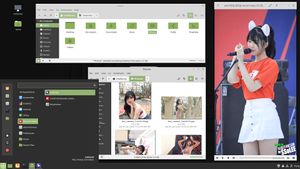 Cinnamon on Linux Mint Cinnamon edition. | |
| The Deepin Desktop environment is a very well-polished desktop environment written using Qt and the Deepin Toolkit (DTK). It provides a very smooth and well-polished desktop experience. It has fewer features than KDE Plasma, but it has enough and there are some additional features KDE Plasma lacks.
The Deepin Desktop environment is primarily developed for the Debian-based Deepin distribution but that is not the only distribution it can be used on. There are Deepin Desktop packages for Arch and Fedora and there is a special Deepin Manjaro Linux spin available. | |
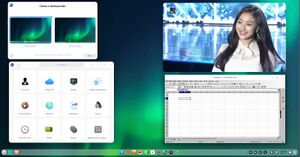 The Deepin Desktop environment running on Deepin Linux. | |
| KDE Plasma is a very advanced and feature-rich desktop environment with a ton of features and choices. You can customize it in every way possible.
KDE Plasma is NOT entirely stable and it does crash from time to time. It has bugs and a lot of them. As an example, if you set the window-manager to always show utility-windows the taskbar auto-hiding stops working. Some icon themes can be installed from it's Plasma Discover application store, others fail. Configuring a setting may apply that new setting but still show the old one. There's a lot of glitches like that. Bugs aside, KDE Plasma is the most advanced and feature-rich desktop environment of all desktop environments and that includes all alternatives on GNU/Linux as well as Windows and macOS. | |
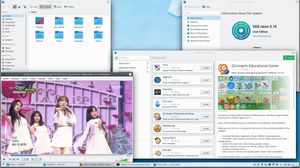 KDE Plasma running on KDE Neon. | |
| Lumina is a desktop environment consisting of a desktop with icons, a panel with a menu and the fluxbox window manager (which can be used stand-alone). It is meant to be light-weight desktop environment.
It does use very little RAM but it is otherwise quite the resource-hog in many respects. Its startup time upon login is unacceptably long, and this is specially true when you consider that Lumina is advertised as a "lightweight" desktop. It is also very slow and sluggish when you use it, simple things like searching for applications or browsing the menu is unacceptably slow. IceWM, LXQt and even Xfce are much better choices if you want a lightweight desktop environment. Lumina does not use systemd, DBus, PolicyKit or other under the hood Linux technologies so there's that. | |
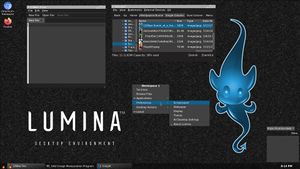 Default Lumina desktop with its file manager. | |
| LxDe was a light desktop-environment made using the GTK libraries. The developers abandoned to re-make it using the Qt Libraries under the name LXQt. It is still available in many distributions and you can still use it - but do be aware that there will be no more updates, bug-fixes or support of any kind. | |
| LXQt is a basic light desktop-environment built on Qt by the people who were formally developing LxDe. It does not have it's own window manager but does have a configuration tool for Openbox. It has panels with a limited number of panel applications, a desktop with icons and the rest of the basics covered. It is light and responsive on old or weak hardware.
The Openbox window manager LXQt defaults to does not support compositing. It is possible to use other window managers like Xfce's xfwm4 or KDE's kwin if this is a deal-breaker. | |
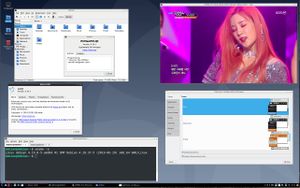 LXQt on Debian 10 Buster. | |
| Xfce is a light-weight desktop environment built on GTK+. It provides a "traditional" desktop experience: Panels, a desktop with icons, a system tray and a efficient window manager with all the bases cover.
Development is slow and steady. There are no bugs, no problems, it just works. Xfce does lack many of the more advanced and fancy features KDE Plasma has such as Exploding Windows, Wobbly Windows, applications running on the desktop and so on. It provides a simpler desktop experience but it is not too simple, all the basics are there. Xfce makes up for what it lacks in terms of fancy eye-candy features by being rock solid stable, bug-free and efficient. Xfce does not have a complete set of applications built specifically for it like KDE Plasma and GNOME. KDE software and most other software works perfectly in Xfce with GNOME "apps" being a notable exception since they tend to be brokenly written to only run on GNOME. | |
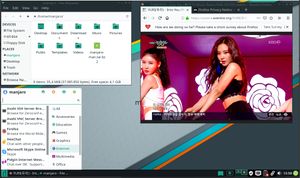
| |
| GNOME - default on distributions. Some like it. Others find it to be something better suited for phones or tablets. It uses a lot of JavaScript for the interface which makes it really memory hungry and wasteful. Development policy appears to remove any choice since having choices "confuse users". They are in full seriousness debating if they should remove all support for changing icon themes and colors because it gives users "an inconsistent GNOME experience". | |

|
Window-managers[edit]
| IceWM provides the basic and essential desktop functionality using minimal resources. It is in principle just a stacking window manager but its features do not end there. There's more. IceWM has a panel which it calls a "taskbar", a virtual workspace switcher, an application list, network monitoring and a panel clock. There is no support fancy panel applications or anything like that. The desktop can have icons and right-clicking the desktop produces a menu.
IceWM is really light. The window manager itself uses 20-50 MB RAM depending on how it is configured. A ready to use IceWM desktop with X and all the system daemons uses around 220 MB RAM on Debian and around 170 MB on AntiX. | |
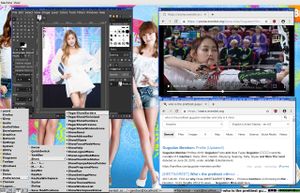 IceWM 1.5.5 running on Gentoo Linux. | |
| Fluxbox is a very light-weight window-manager. It does window management, it provides a very thin and small panel with a list of windows and it shows a menu when you right-click the root window. It's also got a system tray. There is no icons on the desktop, there's no panel applications, there's no built-in program for setting the desktop wallpaper or anything like that (you can, of course, use another program to set the wallpaper). You can run X and Fluxbox just fine on a machine with as little as 256 MB RAM. Or less. We did, in fact, claim 48 MB for Fluxbox+idesk in an old article titled "What Linux Desktop is the Best? Gnome, KDE or something completely different?" in 2004.
Fluxbox is a great choice if you are looking for a very light window-manager which provides a most basic desktop experience. | |
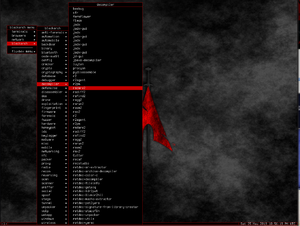
|


Enable comment auto-refresher
Chaekyung
Chaekyung
Dominique Mochel
Permalink |
Anonymous (3c3d8ddcf7)
Permalink |
Anonymous (69c111bb8e)
Anonymous (3057e33f97)
Permalink |
Anonymous (ea9485df7d)
Permalink |
Anonymous (ee45b8e46d)
Permalink |